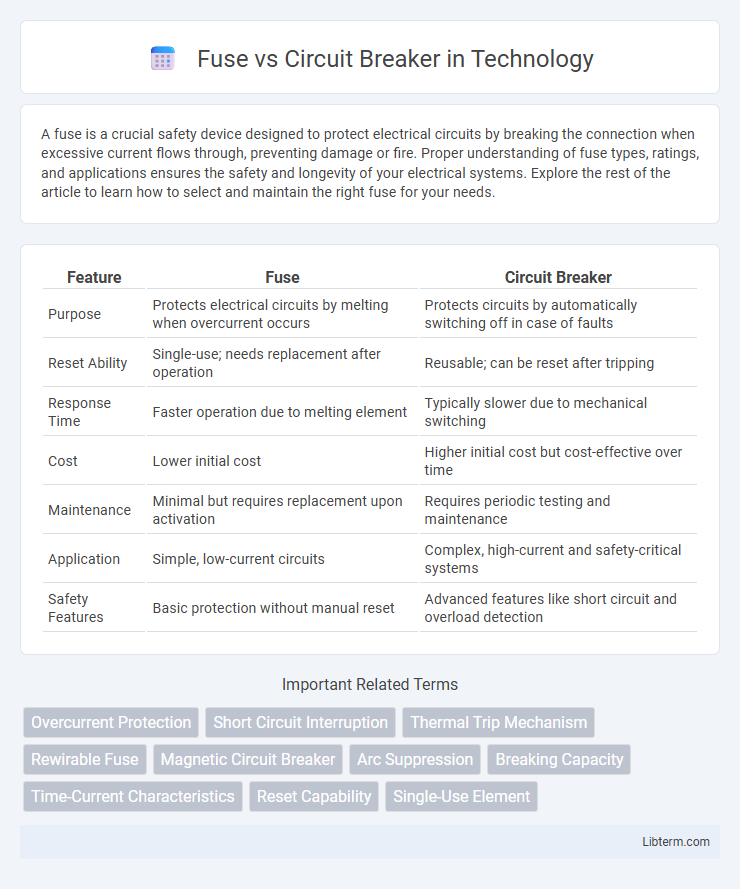A fuse is a crucial safety device designed to protect electrical circuits by breaking the connection when excessive current flows through, preventing damage or fire. Proper understanding of fuse types, ratings, and applications ensures the safety and longevity of your electrical systems. Explore the rest of the article to learn how to select and maintain the right fuse for your needs.
Table of Comparison
| Feature | Fuse | Circuit Breaker |
|---|---|---|
| Purpose | Protects electrical circuits by melting when overcurrent occurs | Protects circuits by automatically switching off in case of faults |
| Reset Ability | Single-use; needs replacement after operation | Reusable; can be reset after tripping |
| Response Time | Faster operation due to melting element | Typically slower due to mechanical switching |
| Cost | Lower initial cost | Higher initial cost but cost-effective over time |
| Maintenance | Minimal but requires replacement upon activation | Requires periodic testing and maintenance |
| Application | Simple, low-current circuits | Complex, high-current and safety-critical systems |
| Safety Features | Basic protection without manual reset | Advanced features like short circuit and overload detection |
Introduction to Fuses and Circuit Breakers
Fuses are protective devices designed to interrupt electrical flow when current exceeds a specific rating, preventing damage by melting a metal wire or strip. Circuit breakers perform a similar function but can be reset after tripping, using mechanical switches triggered by overloads or short circuits. Both devices safeguard electrical systems by isolating faults, with fuses relying on a one-time operation and circuit breakers offering reusable protection.
How Fuses Work: Basic Principles
Fuses protect electrical circuits by using a metal wire or strip that melts when excessive current flows through it, thereby interrupting the circuit and preventing damage. The melting point of the fuse element is carefully selected based on the circuit's current rating to ensure precise and reliable protection. This simple mechanism allows fuses to act as sacrificial devices that need replacement after a fault, unlike circuit breakers which can be reset.
Understanding Circuit Breaker Mechanisms
Circuit breaker mechanisms operate by interrupting electrical flow through an automatic switch triggered by excessive current, protecting circuits from overloads and short circuits. Unlike fuses, which melt to break the circuit once current thresholds are exceeded, circuit breakers can be reset manually or automatically, offering reusable and reliable protection. Key components include an electromagnet or bimetallic strip that senses fault conditions, instantly opening the circuit to prevent damage and enhance safety.
Key Differences Between Fuses and Circuit Breakers
Fuses and circuit breakers both serve to protect electrical circuits from overloads by interrupting current flow, but they operate differently; fuses contain a metal wire that melts when current exceeds a specific threshold, while circuit breakers use an internal switch mechanism that trips under excessive current. Fuses are single-use devices that require replacement after blowing, whereas circuit breakers can be reset multiple times without replacement. Circuit breakers offer faster response times and greater reliability for repeated use, making them preferable for modern electrical systems.
Pros and Cons of Using Fuses
Fuses offer the advantage of rapid response to overcurrent conditions, providing reliable protection for electrical circuits by melting and breaking the circuit when current exceeds safe levels. They are typically cheaper and simpler than circuit breakers, requiring no maintenance or resetting; however, fuses must be replaced after a single use, causing potential downtime. The inconvenience of replacement and lack of reusability are the primary drawbacks compared to circuit breakers, which can be reset and reused multiple times.
Advantages and Disadvantages of Circuit Breakers
Circuit breakers offer the advantage of easy reset after tripping, eliminating the need for replacement unlike fuses, which must be replaced once blown. They provide better protection for electrical circuits due to faster response times and the ability to withstand multiple trips without damage. However, circuit breakers are generally more expensive upfront and more complex in design, which can lead to higher maintenance costs compared to the simpler and less costly fuse.
Safety Considerations for Electrical Protection
Fuses provide reliable overcurrent protection by melting the metal wire inside when excessive current flows, preventing electrical fires but require replacement after one-time use. Circuit breakers offer reusable protection with the ability to quickly disconnect the circuit during short circuits or overloads, enhancing safety through manual or automatic reset capabilities. Both devices must be correctly rated and installed to ensure optimal protection against electrical hazards and reduce risks of electrical shocks or equipment damage.
Applications: Where Fuses and Circuit Breakers Are Used
Fuses are commonly used in residential appliances, electronic devices, and automotive circuits due to their simplicity and cost-effectiveness in protecting against overcurrents. Circuit breakers are preferred in industrial plants, commercial buildings, and large electrical distribution systems where frequent resetting, higher capacity, and reliable fault interruption are critical. Both devices ensure electrical safety but are selected based on application requirements such as current rating, reset capability, and system complexity.
Cost and Maintenance Comparison
Fuses generally have a lower initial cost compared to circuit breakers, making them a cost-effective choice for simple electrical protection needs. Maintenance for fuses involves replacing the blown element, which can lead to downtime and additional replacement expenses over time. Circuit breakers, despite a higher upfront cost, offer easier maintenance with reset capabilities and enhanced longevity, reducing long-term operational costs in complex or critical electrical systems.
Choosing the Right Protection: Fuse or Circuit Breaker?
Selecting the right electrical protection involves evaluating the specific application requirements, such as current rating, response time, and reset capability. Fuses offer fast-acting overcurrent protection with a one-time use design, making them suitable for smaller, cost-sensitive circuits, while circuit breakers provide reusable protection with adjustable trip settings ideal for complex systems requiring frequent resets. Understanding the operational environment and maintenance preferences ensures optimal safety and efficiency in power distribution systems.
Fuse Infographic

 libterm.com
libterm.com